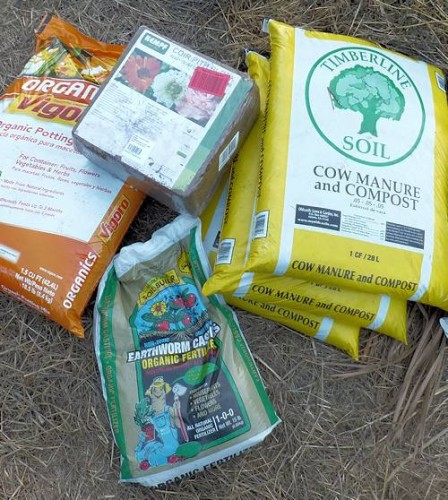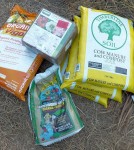Soils and Soil Amendments
What’s the dirt on soil and amendments? Do you just need “plain old dirt” or some fancy mixture in order to get a nice harvest of peppers? Let’s get down and dirty, and talk about soils and amendments.

Some soil amendments, including coconut coir, earthworm castings and composted manure.
Three Main Soil Types
In the grand scheme of things, there are three main soil types found in nature. Yes, there are lots of sub-types, but they all ultimately fall into these three:
- Sandy: Whether coarse or fine grained, sand is most notable for its drainage, which is excellent. Unfortunately, it’s usually a little too excellent, and your plants get thirsty again a short time later.
- Clay: Clay, on the other hand, keeps moisture in the soil…a little too efficiently. Clay soils stay wet for a long time, and they compact easily, so plant roots have a tough time trying to get air.
- Loam: What we all wish we had! Loam has good drainage, but keeps moisture in the soil. It’s “fluffier” and although it will compact down, it doesn’t do it as readily as clay.
If you’ve got an in-ground garden and have sandy or clay soil, they would both benefit from adding some good-quality compost. Compost has the effect of trapping moisture in sandy soils, while “fluffing” up clay soil. And what about loam? Adding compost at least once a year to your beds will help to keep your loam in top condition.
But…what if you have a raised bed or container garden?
Soils for Containers and Raised Beds
First, it’s more appropriate to call what’s put into raised beds and containers a “potting mix”. That’s because there’s usually very little soil in the mix.
These potting mixes are usually composed with some combination of:
- Compost:Â Used for adding structure to the mix.
- Vermiculite or Perlite:Â Used to provide air space for roots.
- Peat Moss or Coconut Coir:Â Used to help retain moisture in the mix.
There are other goodies that can be added, but these are the main ingredients.
Yes, there are all kinds of recipes for the above. The most well-known is called “Mel’s Mix” which is 1/3 vermiculite, 1/3 peat moss and 1/3 blended compost. My personal favorite includes some additional amendments.
Soil / Mix Amendments
These are “goodies” added to the soil that aid the plant’s nutrition in some way. The most common is earthworm castings, which both conditions the soil / mix as well as provides some organic fertilizer. Another amendment along these lines is kelp meal
Something newer to the world of gardening are the rock dusts. These are full of trace minerals that tend to be missing from pretty much all soils and mixes. These rock dusts range from dolomite limestone (found in most garden centers) up through mixes like Azomite, Elemite and Gaia Green Glacial that tend to be more difficult to locate (I get mine from Amazon and/or Ebay, since I can’t find them locally).
Earthworm castings and kelp meal are pretty well-recognized as being useful soil / mix amendments. Rocks dusts? I am currently running some tests, and although initially encouraging I still have more testing to do. However, I do hear a lot of good things about rock dusts. In fact, Earthboxes come with a package of rock dust with 16 trace elements, so it’s definitely gaining in popularity. I’ll be doing a post on rock dusts at some point.
Where is the Fertilizer?
Yes, technically you could call fertilizer (N-P-K) a soil amendment, but that’s a subject that calls for its own post. And in fact, I do have one on organic fertilizers, if you’d like to read it.
Should You Add Soil Amendments?
Whether you have in-ground garden beds, containers or raised beds, it’s probably a given that you need amendments of some sort. The question is what kind and how much?
Compost is what I’d recommend for pretty much anyone. After that, it’s a matter of what you can afford, although minimally I would suggest vermiculite and/or perlite for aeration if you have heavier clay soil, and peat moss or coconut coir for sandy soils to help hold in some moisture.
Earthworm castings and kelp meal are excellent soil conditioners, while the rock dusts add the trace minerals.
Can your grow your peppers in less than optimal soil? Sure you can; it’s more a matter of what kind of harvest you want. Adding soil amendments help your plant to grow healthier, which in turn lets the peppers flower and fruit more.
Organic Fertilizer and Growing Peppers
My preference is for organic fertilizer, especially when it comes to growing anything (like peppers) that I plan to eat.  And while I realize that not everyone is comfortable with using organic, I really do think it’s best.
Organic Fertilizer and Worms
Now my absolute favorite is worm castings, but in the past it’s been difficult to find in small enough quantities for a reasonable price. However, here are some earthworm castings in the smaller quantities — I usually get it in the 15 lb size.
I like earthworm castings because they have always seemed to me (in my growing) that the plants just like the nutrients the castings give to the soil. No burning, totally organic, but nevertheless, quite concentrated; a fairly little amount can fertilize a lot of plants. Instead of mixing it in with my potting mix or garden soil, I just put a handful in each hole before I plant my seedlings or starters.
But I’ve found something else pretty recently that I like; it’s called Terracycle organic fertilizer.
You may be asking…TerraCycle? What the heck it that? Well, it’s liquified worm castings…or as described on the container, “worm poop”. Inelegant, but accurate. ;)  So, think worm castings, dissolved in water so that it’s neat and super-easy to use on your plants.
And one other thing about TerraCycle is that it’s actually packaged in recycled materials, which is better for the environment.  So altogether it’s great for the organically-inclined gardener.
Other Organic Fertilizers
Another organic fertilizer that I like is called fish emulsion. Yep, it’s pretty much what it sounds like; liquified fish. Great for the plants, although a little on the aromatic side. Still, it feeds the soil as well as the plants, so it still gets a two thumbs up in my book. You’ll find it in just about any garden center. Sometimes it’s in a power form other times it’s a concentrated liquid. In either case, you need to add water to it before using.
Can’t forget about plain old compost! You can buy it pretty much at any garden center, but try to find one labeled organic. I know, in theory it should be organic by definition, but labeled organic means that the manufacturer had to pass some pretty stringent guidelines to be able to call it organic.
If you have the space and the time to make your own compost, it’s absolutely fantastic!!!! I highly recommend it. Basically you need things like household garbage (not including anything with protein, fat or plastic) and a means to compost it, like a compost bin. Personally, I am eyeing the Yimby Tumbler Composter
— it’s on my wish list.
It generally takes a few months to create good compost, but there are some that can create compost in a month or so. But whether it’s one month or six months, the most important thing is that the result is well-composted. Here’s a hint; it’s ready when there is no smell to the compost; if it still has an odor, it’s not “done”.
Let’s not forget about cow or horse manure. Cow manure is easily found in a garden center. Horse manure is generally only available if you have horses or know someone else who does.  Poultry manure is relatively easy to locate as well.
These are the major organic fertilizers that are whole-plant. There are others that can be used as supplements, such as blood meal and bone meal. There are also soil amendments like vermiculite, perlite, coconut coir and sphagnum moss that can help you to lighten dense soils. You can also check out my post on soil amendments for more info.
